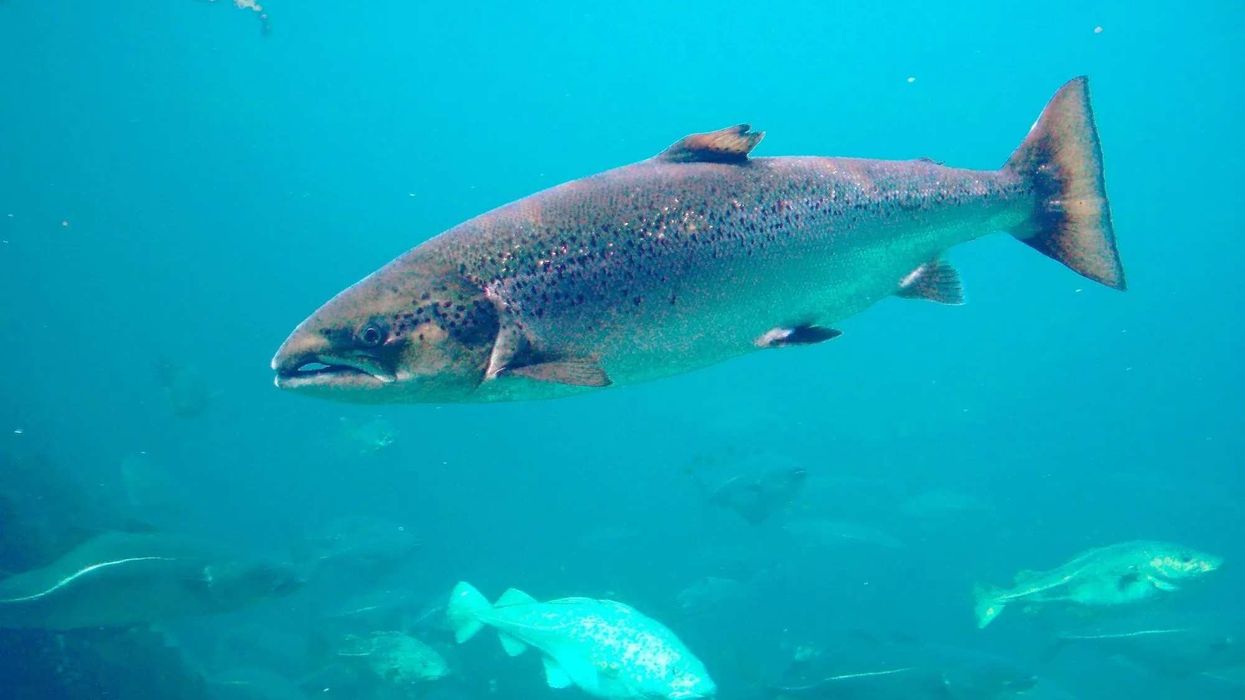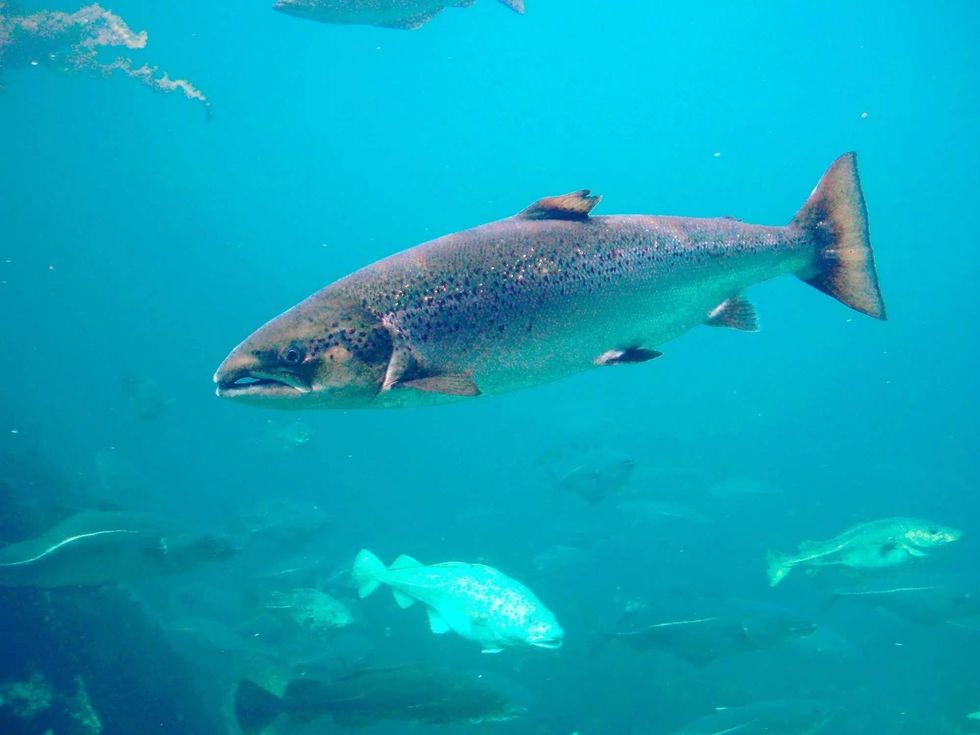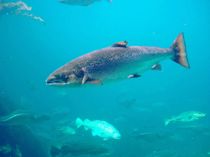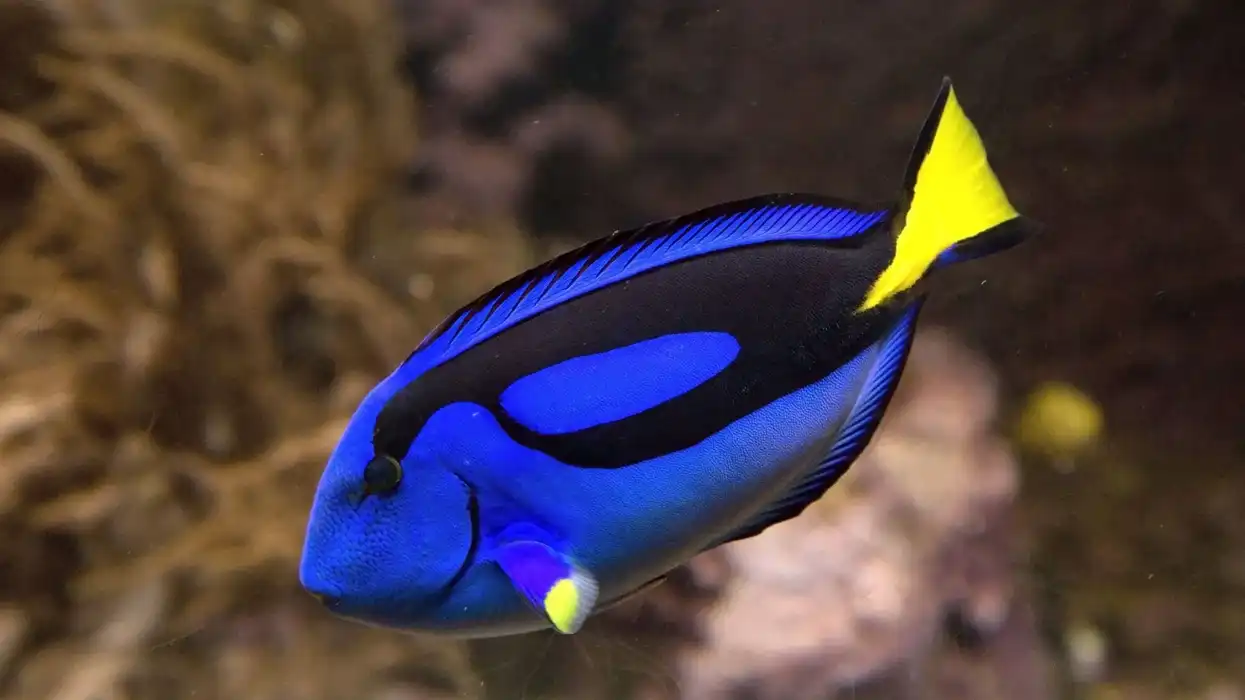Fun Atlantic Whitefish Facts For Kids

The Atlantic whitefish, Coregonus huntsmani, is a member of the Salmonidae family. The Atlantic whitefish is considered to be the most ancient representative of all species of whitefish in North America genetically.
It is anadromous, meaning that it lives most of its life at sea and only spawns in fresh water. It is a dazzling fish that possess silvery sides, a dark blue-to-dark green back, and a white belly.
It has a dusky forked tail fin and a dorsal fin. It ranges between 7.8-19.6 in (20-50 cm).
This magnificent species is endemic to Canada and occurs only in the Petite Rivière watershed and the Tusket River in Nova Scotia's southern region. It inhabits cool water habitats and cannot be seen near the surface when it is the summer season.
It feeds upon marine warms, small periwinkle, amphipods, invertebrates, and small fish. The population of this species is currently threatened and the population in the Tusket River has been eradicated completely.
The population in the Petite Rivière watershed might represent the only remaining population of this species. This species faces many significant threats like water pollution and the illegal introduction of invasive species like chain pickerel and smallmouth bass. Keep reading to dive deeper into the world of the Atlantic whitefish!
If you enjoyed reading our Atlantic whitefish fun facts, you must check out our white cloud mountain minnow surprising facts and clown rasbora interesting facts!
Atlantic Whitefish Interesting Facts
What type of animal is an Atlantic whitefish?
The Atlantic whitefish, Coregonus huntsmani, is a species of fish. It is a member of the family of trouts and salmons, Salmonidae.
It feeds upon marine warms, small periwinkle, amphipods, invertebrates, and fish. It occurs only in Canada, specifically in three freshwater lakes of the Petite Rivière watershed in Nova Scotia. The Atlantic whitefish is endangered currently and faces many threats, including its interactions with the chain pickerel and smallmouth bass, which are illegally introduced invasive species.
What class of animal does an Atlantic whitefish belong to?
The Atlantic whitefish, Coregonus huntsmani, belongs to the class Actinopterygii.
How many Atlantic whitefish are there in the world?
The population of the Atlantic whitefish in the world has not been evaluated yet. However, this fish is currently endangered and faces many threats.
It is endemic to Canada and occurs only in the Petite Rivière watershed and the Tusket River in Nova Scotia. The population in the Petite Rivière watershed is the only population in the wild of Atlantic whitefish in the world.
This fish is threatened by invasive species like chain pickerel and smallmouth bass.
The anadromous population of this species has diminished due to the dam construction in the Petite Rivière creating a poor fish passage between the lakes and the sea. Pollution and fishing activities also contribute to the decline of this species.
Fisheries and Oceans Canada has released a recovery strategy for the conservation of this species. The purpose of this recovery strategy was to stabilize the current population and also establish its anadromous form again.
Where does an Atlantic whitefish live?
The Atlantic whitefish is endemic to Canada and its population is limited to three freshwater lakes within the Petite Rivière watershed in Nova Scotia. They are Milipsigate, Hebb, and Minamkeak.
These three Petite Rivière lakes serve as a critical habitat for this species in its recovery strategy. Some fish of this species have also been caught in the Petite Rivière's lower sections that are assumed to have strayed from the upper lakes. This species has also been introduced in Dartmouth, Nova Scotia, in Anderson lake.
What is an Atlantic whitefish's habitat?
The anadromous form of this species is believed to have inhabited coastal waters in the summer season and fresh water in the winter season for spawning. The Petite Rivière population of the Atlantic whitefish is lake-resident.
It completes its life-cycle dwelling in freshwater only. The habitat of the Atlantic whitefish is restricted to three interconnected freshwater lakes within the Petite Rivière watershed.
All three of these lakes have rocky shorelines and silt bottoms. The Atlantic whitefish resides at depth of 55.7 ft (17 m) in the Hebb lake, 52.4 ft (16 m) in the Milipsigate lake, and at 42.6 ft (13 m) in the Minamkeak lake.
Who do Atlantic whitefish live with?
This fish species is sociable and they have been spotted swimming in schools.
How long does an Atlantic whitefish live?
The Atlantic whitefish can live for two to four years in its natural habitat in the wild and has been recorded to live up to nine years in captivity.
How do they reproduce?
There hasn't been much research about the reproduction of this species in the wild. However, we do know that the spawning season of the Atlantic whitefish starts in mid-November and goes on until early January.
The number of eggs they spawn is unknown. However, we do know that the eggs are adhesive and buoyant and settle on lake substrates. Juveniles Atlantic whitefish have been observed to inhabit nearshore regions.
What is their conservation status?
The Atlantic whitefish has been classified in the Critically Endangered category by the IUCN's Red List. It has also been listed under the federal Species at Risk Act (SARA) as Endangered.
The Committee on the Status of Endangered Wildlife in Canada (COSEWIC) also has classified this species as endangered. The Atlantic whitefish is listed as endangered due to many significant threats.
Smallmouth bass and chain pickerel are illegally introduced invasive species that are harmful to the existing population of Atlantic whitefish. The population of this species in the Tusket River was mainly diminished due to the damming of the Tusket River as it caused abruptions in the migration route of the Atlantic whitefish.
The increasing acidity in some regions of the river has also affected the breeding of this species.
Poaching in the Tusket River fishways has also contributed towards their decline. Recovery actions are being taken to conserve this species, such as the shutting down of recreational angling in certain areas.
Fishing the Atlantic whitefish is prohibited by the Nova Scotia Fishery Regulations under the Federal Fisheries Act. There is also a recovery program in progress under the Species at Risk Act (SARA).
Atlantic Whitefish Fun Facts
What do Atlantic whitefish look like?
The Atlantic whitefish looks quite spectacular. It has a dark blue-to-dark green back, silvery sides, and a plain white belly.
The body of this fish is elongated and the mouth is present at the snout's end. An adult Atlantic whitefish ranges between 7.8-19.6 in (20-50 cm) in length.
The lower fins of this fish are light-colored whereas the forked tail fin and the dorsal fin are dark-colored. Like all the members of the Salmonidae family, there is also a fleshy, small-sized fin present between the tail and dorsal fins of the Atlantic whitefish.
This fish is commonly confused with the cisco (Coregonus artedi) and the lake whitefish (Coregonus clupeaformis) that are widespread across North America.
However, the Atlantic whitefish is distinct from these species genetically. It differs from lake whitefish physically as well.
The mouth of the Atlantic whitefish is present at the snout's end whereas the mouth of the lake whitefish is present below the snout. The Atlantic whitefish also has well-developed teeth whereas the lake whitefish does not possess any.
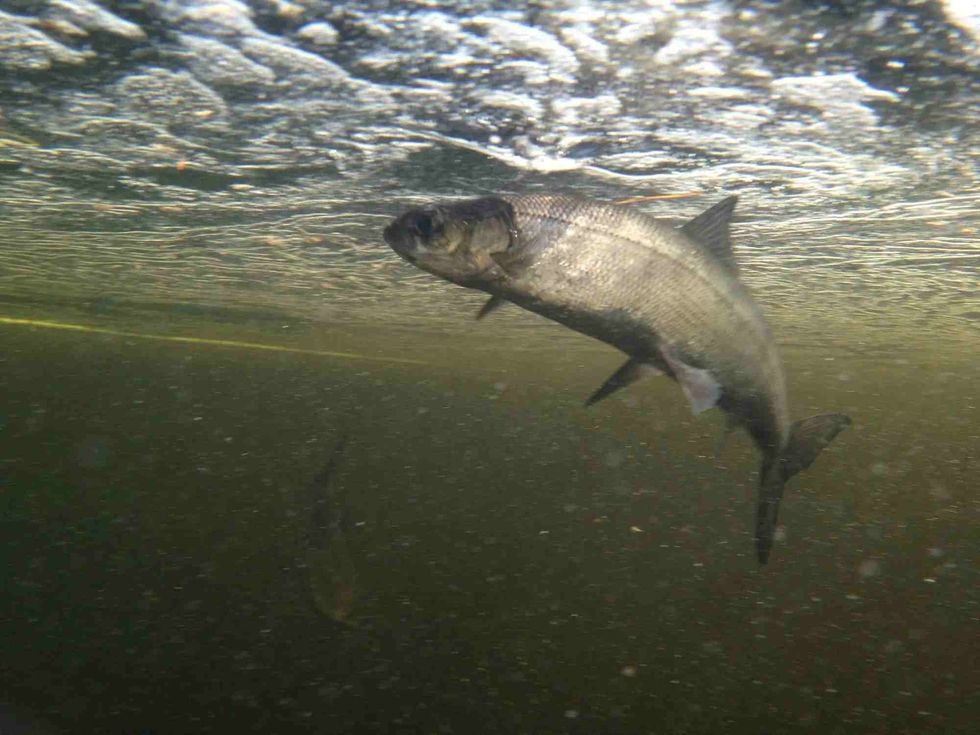
How cute are they?
This species of fish has silvery sides that can give them points for cuteness! They exist only in Canadian waters and can be endearing to some fish lovers.
How do they communicate?
It is not known how these fish communicate. However, we do know that many members of the Salmonidae family communicate by darkening and lightening their skin color!
How big is an Atlantic whitefish?
The Atlantic whitefish has an elongated body that ranges between 7.8-19.6 in (20-50 cm) in length. These fish are 20 times longer than tetras!
How fast can an Atlantic whitefish swim?
The speed of this fish has not been evaluated yet. However, as the tail fin of this species is forked, it can be assumed that they can swim fast.
How much does an Atlantic whitefish weigh?
The Atlantic whitefish range between 3.9-7.9 lb (1.8-3.6 kg) in weight.
What are their male and female names of the species?
No specific names have been assigned to males and females of this fish species.
What would you call a baby Atlantic whitefish?
Like the babies of other fish, baby Atlantic whitefish can be referred to as fry.
What do they eat?
These fish are carnivorous and they feed upon marine warms, small periwinkle, and amphipods. They have been observed to consume invertebrates and fish in the spring and fall seasons. Smallmouth bass and chain pickerel are invasive species that prey upon the Atlantic whitefish.
Are they dangerous?
No, these fish aren't dangerous.
Would they make a good pet?
As these fish are listed as endangered, they cannot be kept as a pet.
Did you know...
The Atlantic whitefish was previously referred to as the Acadian whitefish!
The Atlantic whitefish is Canada's first species of fish to be classified by the Committee on the Status of Endangered Wildlife in Canada (COSEWIC) as endangered!
A whitefish was caught in 1998 that had a whopping weight of 13 lb (5.8 kg)!
Do whitefish have teeth?
Whitefish species are trout-like as they have an adipose fin. They also possess weak teeth, large scales, and small mouths. Some species of whitefish do not possess any teeth.
Why is the Atlantic whitefish endangered?
The endangered Atlantic whitefish occurs only in North America, specifically in the three freshwater lakes of the Petite Rivière watershed in Nova Scotia.
The last remaining population of Atlantic whitefish faces many threats such as non-native fish species such as smallmouth bass and chain pickerel in their habitat, the damming of the Tusket River, and the poor fish passage between the lakes in the Petite Rivière and the sea.
Recreational fishing and poaching of the endangered Atlantic whitefish has also added to the decline of this species.
Recovery actions are in process to stabilize the current population and establish the anadromous form of Atlantic whitefish again.
There are numerous recovery actions being taken for the recovery of the population of this species. The DFO collaborated with the Bluenose Coastal Action Foundation on the Atlantic Whitefish Recovery Project to create awareness about Atlantic whitefish.
The Bluenose Coastal Action Foundation also monitors the fishway at the Hebb Lake Dam that was constructed by the Bridgewater Public Service Commission to facilitate fish passage.
Here at Kidadl, we have carefully created lots of interesting family-friendly animal facts for everyone to discover! Learn more about some other fish from our salmon surprising facts and Florida pompano facts for kids pages!
You can even occupy yourself at home by coloring in one of our free printable Atlantic whitefish coloring pages! *Please note that the main image is of an Atlantic salmon, not an Atlantic whitefish. If you have an image of the Atlantic whitefish, please let us know at hello@kidadl.com
We Want Your Photos!
More for You
See All
Bachelor of Business Administration specializing in Management

Rhea NischalBachelor of Business Administration specializing in Management
A background in Business Administration and Management from MCM DAV College, Rhea has led her to work for her father's global business. However, her passion for content production, where she manages operations to ensure all processes run smoothly. Outside of work, she enjoys playing the piano and spending time with her one-year-old nephew.
Bachelor of Arts specializing in Economics

Gowri RaoBachelor of Arts specializing in Economics
With a bachelor's degree in Economics from Krea University, Gowri is a highly skilled data analyst and an expert in regression and causation modeling. Her interests in economic trends, finance, and investment research complement her professional expertise. In addition to her professional pursuits, Gowri enjoys swimming, running, and playing the drums, and she is also a talented tutor.
Disclaimer
1) Kidadl is independent and to make our service free to you the reader we are supported by advertising. We hope you love our recommendations for products and services! What we suggest is selected independently by the Kidadl team. If you purchase using the Buy Now button we may earn a small commission. This does not influence our choices. Prices are correct and items are available at the time the article was published but we cannot guarantee that on the time of reading. Please note that Kidadl is a participant in the Amazon Services LLC Associates Program, an affiliate advertising program designed to provide a means for sites to earn advertising fees by advertising and linking to Amazon. We also link to other websites, but are not responsible for their content.
2) At Kidadl, we strive to recommend the very best activities and events. We will always aim to give you accurate information at the date of publication - however, information does change, so it’s important you do your own research, double-check and make the decision that is right for your family. We recognise that not all activities and ideas are appropriate for all children and families or in all circumstances. Our recommended activities are based on age but these are a guide. We recommend that these ideas are used as inspiration, that ideas are undertaken with appropriate adult supervision, and that each adult uses their own discretion and knowledge of their children to consider the safety and suitability. Kidadl cannot accept liability for the execution of these ideas, and parental supervision is advised at all times, as safety is paramount. Anyone using the information provided by Kidadl does so at their own risk and we can not accept liability if things go wrong.
3) Because we are an educational resource, we have quotes and facts about a range of historical and modern figures. We do not endorse the actions of or rhetoric of all the people included in these collections, but we think they are important for growing minds to learn about under the guidance of parents or guardians.
